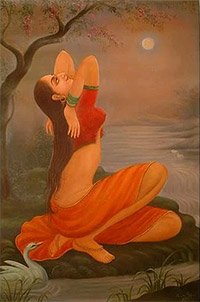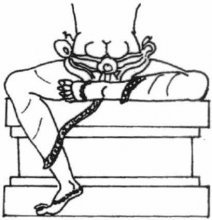Gajahasta, Gaja-hasta: 4 definitions
Introduction:
Gajahasta means something in Hinduism, Sanskrit. If you want to know the exact meaning, history, etymology or English translation of this term then check out the descriptions on this page. Add your comment or reference to a book if you want to contribute to this summary article.
Images (photo gallery)
In Hinduism
Shilpashastra (iconography)
Source: Shodhganga: The significance of the mūla-beras (śilpa)Gajahasta (गजहस्त) or simply Gaja refers to “elephant trunk” and represents one of the four Elirkai gestures, as defined according to texts dealing with śilpa (arts and crafs), known as śilpaśāstras.—Accordingly, pratimā-lakṣaṇa (body postures of the icons) is comprised of hand gestures (hasta, mudrā or kai-amaiti), stances/poses (āsanas) and inflexions of the body (bhaṅgas). There are thirty-two types of hands [viz., gajahasta] classified into two major groups known as tolirkai (functional and expressive gestures) and elirkai (graceful posture of the hand).
(Description of Gaja-hasta): When the hand is stretched straight out, and the palm slopes downward from the wrist, with the fingers bent gracefully like tendrils on a creeper, this regal mudrā reminiscent of an elephant’s trunk, is called gaja-hasta. The palm in this drawing seems to be in the vainayaki-mudrā; in the well-known Naṭarāja images of Śiva, this mudrā is clearly recognizable. This pose is usually met with in images of gods or goddesses shown in the dancing attitude. Śiva Naṭarāja dancing vigorously on the back of Muyalaka or the apasmara-puruṣa, Nṛtya-Gaṇapati, Kṛṣṇa Kāliya damana, dancing Cāmuṇḍa and such other images has one of their hands in this pose.

Shilpashastra (शिल्पशास्त्र, śilpaśāstra) represents the ancient Indian science (shastra) of creative arts (shilpa) such as sculpture, iconography and painting. Closely related to Vastushastra (architecture), they often share the same literature.
Shaivism (Shaiva philosophy)
Source: Brill: Śaivism and the Tantric TraditionsGajahasta (गजहस्त) refers to the “elephant trunk” (method), according to the 13th-century Matsyendrasaṃhitā: a Kubjikā-Tripurā oriented Tantric Yoga text of the Ṣaḍanvayaśāmbhava tradition from South India.—Accordingly, “[The intercourse (saṃga)]:—The Yogin should embrace and kiss her, etc., properly. [Then] he should have sex with her outwardly, very gently, while [performing] visualisation. He should apply the ‘elephant trunk’ (gajahasta) [method] on her divine love temple [i.e. her genitalia]. [...]”.
Note: Gajahasta could be a mudrā to be shown during the ritual (Cf. Kaulāvalīnirṇaya 17.133-135ab), but could as well be the technique mentioned in Jaśodhara’s commentary on Kāmasūtra 7.2.2.

Shaiva (शैव, śaiva) or Shaivism (śaivism) represents a tradition of Hinduism worshiping Shiva as the supreme being. Closely related to Shaktism, Shaiva literature includes a range of scriptures, including Tantras, while the root of this tradition may be traced back to the ancient Vedas.
Kama-shastra (the science of Love-making)
Source: Brill: Śaivism and the Tantric Traditions (kāmasūtra)Gajahasta (गजहस्त) refers to the “elephant trunk” (method of rubbing the female genitalia), according to the Kāmasūtra of Vātsyāyana and Jaśodhara’s commentary called the Jayamaṅgalā .—Accordingly, “[Commentary on verse 7.2.2]:—‘about to practice sex’: at the beginning of the sexual act. This is at the start [of the sexual act]. Even if the passion is weak with regards to sex because the penis is inert, first ‘her genitalia’, i.e. her vulva, should be rubbed with his hand, should be stimulated with the ‘elephant trunk’ (gajahasta) [method]...”.

Kamashastra (कामशास्त्र, kāmaśāstra) deals with ancient Indian science of love-making, passion, emotions and other related topics dealing with the pleasures of the senses.
Languages of India and abroad
Kannada-English dictionary
Source: Alar: Kannada-English corpusGajahasta (ಗಜಹಸ್ತ):—[noun] the long, flexible snout or proboscis of an elephant; a trunk.
Kannada is a Dravidian language (as opposed to the Indo-European language family) mainly spoken in the southwestern region of India.
See also (Relevant definitions)
Full-text: Dandahasta, Gaja, Hasta, Sukhasana, Nataraja.
Relevant text
Search found 6 books and stories containing Gajahasta, Gaja-hasta; (plurals include: Gajahastas, hastas). You can also click to the full overview containing English textual excerpts. Below are direct links for the most relevant articles:
Matangalila and Hastyayurveda (study) (by Chandrima Das)
Elephants in Śaivism < [Chapter 4]
Mythological motifs related to Elephants < [Chapter 4]
The Religion and Philosophy of Tevaram (Thevaram) (by M. A. Dorai Rangaswamy)
Chapter 4.3 - (b) The seven Tandava Dances of Shiva < [Volume 2 - Nampi Arurar and Mythology]
Chapter 4.3 - (c) Sculptures of Shiva and Dance < [Volume 2 - Nampi Arurar and Mythology]
Chapter 3.1 - Tripurantaka-murti (burning down of the three castles) < [Volume 2 - Nampi Arurar and Mythology]
Early Chola Temples (by S. R. Balasubrahmanyam)
Bronze, group 2: Age of Aditya I (a.d. 871-907) < [Chapter XI - Sculpture]
Sittannavasal Frescoes-III < [January-February 1931]
Middle Chola Temples (by S. R. Balasubrahmanyam)
Temples in Attur < [Chapter II - Temples of Rajaraja I’s Time]
Parivaralayattu Pillaiyar < [Tanjavur/Thanjavur (Rajarajesvaram temple)]
Later Chola Temples (by S. R. Balasubrahmanyam)
Temples in Melakkadambur < [Chapter II - Temples of Kulottunga I’s Time]
Related products

